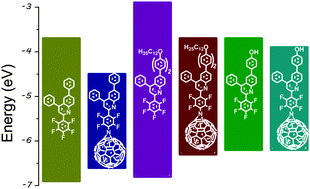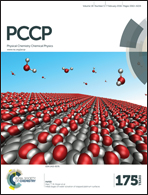Evaluation of the electronic properties of perfluorophenyl functionalized quinolines and their hybrids with carbon nanostructures†
Abstract
Hybrid materials based on perfluorophenyl functionalized quinolines directly attached onto the sp2 hybridized surface of carbon nanostructures have been prepared and studied herein along with their precursor semiconducting small molecules. Tails of different polarities have been used so that the molecules would present improved solubility and controllable affinity for the selected substrates. These materials were evaluated for their electronic and electrochemical properties for potential application in organic photovoltaic solar cells (OPVs), using UPS, XPS and CV measurements after deposition onto oxygen plasma cleaned Si wafers or solvent treated ITO coated glass. A weak interaction between the fluorine atoms and both the Si and the ITO substrates was observed by XPS. The extent of this interfacial interaction was found to be related to the orientation of the quinoline moieties on the organic layer. Moreover, the combination of XPS and UPS analyses showed that the absolute energy value of the HOMO level increased as the amount of surface fluorine atoms increased. CV measurements revealed that hybridisation of the small molecules with carbon nanostructures decreases the materials' energy gap and increases the absolute energy value of the LUMO level. These features prove the efficiency of the proposed method to produce materials with controlled energy levels for solar cell devices.


 Please wait while we load your content...
Please wait while we load your content...